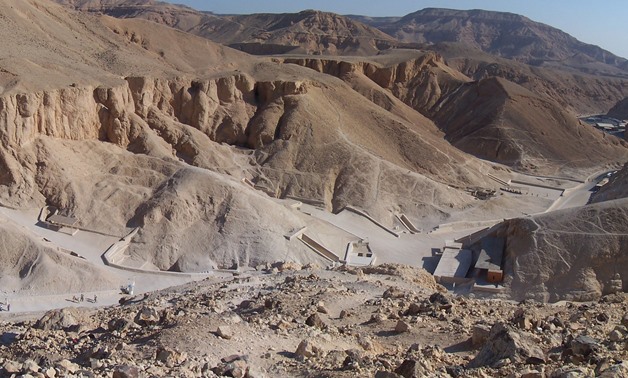https://www.egypttoday.com/Article/4/40627/New-excavation-works-led-by-Zahi-Hawas-take-place-in
 Valley of the Kings –Wikimedia
Valley of the Kings –Wikimedia New excavation works led by Zahi Hawas take place in Luxor
Sat, Jan. 20, 2018
CAIRO – 20 January 2018: The Ministry of Antiquities announced the beginning of new excavation works in Valley of the Monkey, located within Valley of the Kings, after the Permanent Committee for Egyptian Antiquities permitted digging in the site
Led by international Egyptologist and former Minister of Antiquities Zahi Hawas, the forthcoming excavation will be executed by an Egyptian mission.
Uncovering a tomb dated back to the 18th dynasty is the main aim of the forthcoming excavation works. The excavation will take place nearby King Ay's tomb, who succeeded the throne after King Tutankhamun and married his wife Queen Ankhesenamun, according to Mostafa Waziri, secretary general of the Supreme Council of Antiquities, who stated these remarks in a press statement released on the Ministry of Antiquities' official Facebook page.
In 2010, an archaeological mission discovered four foundation deposits indicating the existence of a tomb. The tomb might belong to one of King Tutankhamun's family members, as a collection of knives and pottery vessels from the reign of King Amenhotep III, Tutankhamun's grandfather, were found.
According to the Daily Mail website, Hawas' spokesman stated on Hawas' official website, "The radar scans in the area detected the presence of a possible entrance to a tomb at a depth of five meters (16 feet)."
"It is believed that the location of the tomb of Ankhsenamun, Tutankhamun's widow, who married Ay after Tutankhamun's death, is still hidden somewhere in the Valley of the Monkeys."
The Valley of the Monkeys is a side valley in the Valley of the Kings. It was named for the paintings of the 12 monkeys on King Ay's tomb walls.
Queen Anhkesenamun's name is accompanied with two of the most celebrated kings in Ancient Egyptian history: Akhenaten and Tutankhamun.
Born in an unsettled time during the 18th dynasty reign, she was the sixth daughter of King Akhenaten and Queen Nefertiti; Ankhesenamun, was originally named Ankhesenpaaten, a name meaning that her life would be dedicated to the god Aten, according to researcher and author Ismail Hamed.
Her former name came from her father, Akhenaten, who was known for his rebellious religious beliefs, as he abandoned various Ancient Egyptian gods and unified them in one god only; Aten.
Ankhesenamun was known for her strong and passionate love for her husband, and half-brother King Tutankhamun. They got married while they were young.
Tutankhamun's tomb narrated different forms of their great love story, for example, one can see inscriptions that tell of Ankhesenamun putting roses on her husband's tomb, in addition to the great painting on Tutankhamun's royal seat, according to prominent Egyptologist and author Zahi Hawas.
When Tutankhamun assumed the throne of Egypt, he tried to ease the critical crisis that had risen between the previous ruler and Amun priests, so he changed the royal name, and added "Amun" to the final syllable of the name instead of "Aten".
He also transformed the official religion of Egypt from "Aten" to "Amun", and renamed Tiba as the official capital of the Egyptian Kingdom.
After Tutankhamun's eleven-year reign, Ankhesenamun feared for her safety, and resulted to asking the huthi king to let her marry one of his sons, according to author Hussein Abdel Basir.
-- Sent from my Linux system.
No comments:
Post a Comment